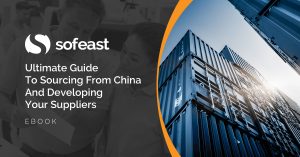Every year, tens of thousands of new businesses start purchasing directly in China. And many of them have a bad first experience. The key to successful China sourcing is not a set of tools — it is primarily a change in mental models.
For example, here is a dangerous way of thinking:
“It is the supplier’s responsibility to ensure my products are made up to specs, in responsible working conditions, and shipped on time.”
Well, not really. When you buy in your own country, it is true. But not in China. Chances are, the supplier has gotten paid in full by the time you receive the products, and legal actions are rather limited if you haven’t got a legally-enforceable contract that calls for litigation within China.
That’s why I always tell buyers that THEY are fully responsible for what happens in production and during shipment. If they don’t give clear targets (regarding timing but also quality and safety) to the supplier and if they don’t check what is really going on, they are the only party to blame should things go wrong.
Here is another one:
“If we could find a smart manufacturer that wants to partner and grow with us, it would be ideal. They would give us good quality for a low price and over time they would get high volumes.”
From my observations, this is not likely to work. If your business really takes off, you will probably have to find another, bigger and/or better supplier. “Partnering” with a buyer is not what Chinese exporters dream of. They want big volumes now so they can boast with their friends (or offer a Porsche Cayenne to their wife so she stays off their back).
And another one:
“We should try to work with a very established manufacturer that sells to many large & famous customers.”
Maybe it is a good idea, if quality is more important than price to you or if you can place large orders. But, if the accumulated amount of your orders in a year is less than a million dollars, a smaller factory might be a better choice. Sourcing is an art.
In my industry, there is another mental model I often have to fight:
“All quality inspectors are corrupt. The factory just gives them money and they look elsewhere.”
With time, this is getting more and more wrong. If you make sure the inspector is well trained, has a perfect sample to use for reference, has a very clear checklist in hand that leaves little space for subjectivity, and if the supplier knows exactly what you expect, the risk of corruption is really low.
To be fair, the manufacturer’s mental model also plays a role. Here is one that drives many buyers mad:
“The buyer keeps insisting about quality, but he knows he won’t be getting high-quality products at the price we quoted. It’s all talk when he complains.”
Price and quality are quasi inseparable in the Chinese mind. And the “no need to discuss it, since it is obvious” cultural convention makes it a never-ending source of misunderstandings between buyers and sellers. To fight this mental model, a good first step is to have a manager at the supplier’s company sign on a checklist and on golden samples.
“Quality problems come from the workers’ laziness.”
Hire a bunch of high school graduates, pay them at the local labor market level, compensate them based on the number of pieces they process, and have them work in unsafe and uncomfortable conditions. Should you expect them to care about customers they have never seen? Of course not.
Factory managers do have methods at their disposal to improve quality. They are fully responsible for anything that goes wrong.
“Why train the workers or give them signs of appreciation? Anyway most of them will be gone by next year.”
Again, factory bosses have it wrong. There is high turnover so they don’t invest in their people. But would turnover be as high if they did make some efforts?
What do you think?
Ultimate Guide To Sourcing From China And Developing Your Suppliers [eBook]
This FREE eBook starts from the beginning, discussing whether you need to hire a sourcing agent, and follows the sourcing process right through to developing a trusted supplier’s quality and productivity.
There are 15 chapters over 80+ pages to explore, providing exhaustive guidance on the entire sourcing and supplier development process from start to finish, including:
- Identifying suppliers,
- Negotiations,
- Quality inspections,
- Developing Chinese suppliers,
- Improving factory quality and productivity,
- and much more…


“It is the supplier’s responsibility to ensure my products are made up to specs…”
My response: There’s a reason why things in China are cheaper.
“If we could find a smart manufacturer that wants to partner and grow with us…”
My response: Whose to say YOU won’t go out of business next month? It’s not like we’ve been working together for a long time.
Yes, good points. Thanks!